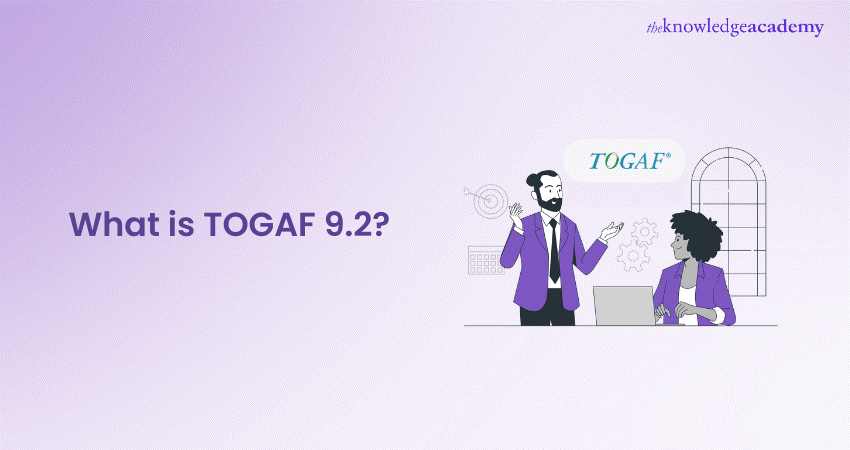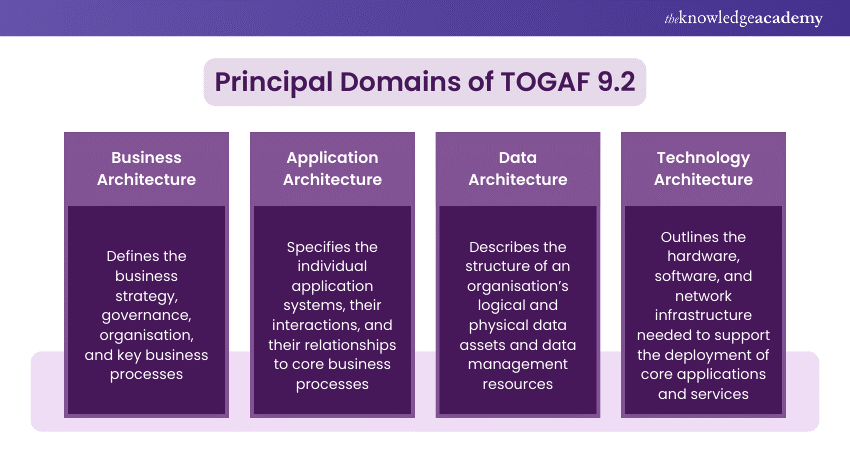We may not have the course you’re looking for. If you enquire or give us a call on 01344203999 and speak to our training experts, we may still be able to help with your training requirements.
Training Outcomes Within Your Budget!
We ensure quality, budget-alignment, and timely delivery by our expert instructors.

Enterprise Architecture is like the master plan for a company’s technology systems. Think of it as the big picture that shows how all the tech parts work together to keep the business ticking like a clock. Now, you might wonder, what is TOGAF? It’s like the rule book for creating these awesome tech blueprints. It guides tech architects in designing a tech world that’s not just smart for today but also ready for what’s next! Read this blog to learn more.
Table of Contents
1) Understanding What is TOGAF 9.2?
2) How does TOGAF 9.2 work?
3) Introduction TOGAF 9.2 training
a) Components of TOGAF 9.2 framework
4) Conclusion
What is TOGAF 9.2?
The Open Group Architecture Framework, or TOGAF 9.2, is a comprehensive Enterprise Architecture framework that offers a detailed approach for designing, planning, implementing, and overseeing an enterprise’s information architecture. It is the current version of the framework, regularly updated to align with the evolving needs and trends in business technology architecture.
Globally, organisations adopt TOGAF to enhance business efficacy through established practices for the development and management of IT Architecture. The key strengths of TOGAF 9.2 include a suite of tools, refined guidelines, and a systematic approach designed to adeptly navigate the complexities of today’s IT landscapes.
How does TOGAF 9.2 work?
TOGAF 9.2 is a framework that assists organisations in crafting, evaluating, and constructing the optimal architecture to meet their specific needs. It is underpinned by a cyclical process model complemented by a repository of best practices and reusable architectural assets.
The structure of TOGAF 9.2 encompasses four principal domains: Business Architecture, Application Architecture, Data Architecture, and Technology Architecture, collectively known as the Architecture Development Method (ADM). The ADM provides a methodical sequence of steps that guide organisations in the creation and governance of their Enterprise Architecture.

The methodology initiates with the Preliminary Phase, which involves delineating the scope, pinpointing stakeholders, and instituting the architectural framework. Subsequent phases navigate through the management of requirements, the formulation of architecture, its validation, and the oversight of implementation.
Each phase incrementally hones and corroborates the strategy and its deliverables. The concluding stages concentrate on the management of architectural changes and the fulfilment of requirements, ensuring the architecture’s ongoing alignment with the evolving demands of the business.
Boost your earning potential by gaining TOGAF certification –register in TOGAF® Foundation And Practitioner now!
Introduction TOGAF 9.2 training
TOGAF 9.2 training prepares an individual to learn, gain competency, and be enabled to apply knowledge of the framework. The training gives participants a much better understanding of the architectural framework in structure, and it is very useful for architectural project work. The training will greatly benefit Architects, Project Managers, and all those working in the areas of conceiving, designing, developing, implementing, and maintaining Enterprise Architecture projects.
Components of TOGAF 9.2
1) Architecture Development Method (ADM) - This is the heart of TOGAF, a robust, proven method for developing and managing enterprise IT Architecture.
2) ADM guidelines and techniques - These provide additional details on how to apply ADM to specific organisational environments.
3) Architecture content framework - It provides a detailed model of the architectural work products, including deliverables and building blocks.
4) Enterprise continuum & tools - This offers a set of tools for classifying and storing organisational assets.
5) Reference models - The TOGAF Foundation Architecture and the Integrated Information Infrastructure Reference Model jointly offer a set of common architectural elements.
6) Architecture capability framework - This is a framework of detail to define organisational structure, skills, roles, and responsibilities that are to be in place for the operation of an architecture function in an enterprise.
With this training, the trainees would understand those elements and how they work together for a holistic framework that supports the long-term success of enterprise IT developments.
Conclusion
Understanding "What is TOGAF 9.2?" equips you with the insights needed to implement a comprehensive architecture framework that is instrumental in aligning business goals with IT strategy. Whether you're a professional looking to enhance your skills or an organisation aiming to improve your IT Architecture, TOGAF 9.2 offers the tools and methodologies to achieve these objectives efficiently. Embrace TOGAF 9.2 and set the foundation for a resilient and adaptive Enterprise Architecture.
Sign up for TOGAF® Foundation and Practitioner - Foundation Course accredited by The Open Group to boost your career in Enterprise Architecture!
Frequently Asked Questions

TOGAF 9.2 is currently the latest update of the framework, known for its refined structure and guidelines that align with recent technological trends. TOGAF 9.2 remains the most advanced and comprehensive version available for Enterprise Architecture.

Yes, TOGAF is highly useful for cloud architecture as it provides a systematic approach to designing, implementing, and managing cloud infrastructures effectively, aligning IT strategies with business goals.

The Knowledge Academy takes global learning to new heights, offering over 30,000 online courses across 490+ locations in 220 countries. This expansive reach ensures accessibility and convenience for learners worldwide.
Alongside our diverse Online Course Catalogue, encompassing 17 major categories, we go the extra mile by providing a plethora of free educational Online Resources like News updates, Blogs, videos, webinars, and interview questions. Tailoring learning experiences further, professionals can maximise value with customisable Course Bundles of TKA.

The Knowledge Academy’s Knowledge Pass, a prepaid voucher, adds another layer of flexibility, allowing course bookings over a 12-month period. Join us on a journey where education knows no bounds.

The Knowledge Academy offers various TOGAF Training, including the TOGAF® Foundation and Practitioner Training and TOGAF® BA Foundation Training. These courses cater to different skill levels, providing comprehensive insights into TOGAF Certification.
Our Business Improvement Blogs cover a range of topics related to TOGAF, offering valuable resources, best practices, and industry insights. Whether you are a beginner or looking to advance your TOGAF skills, The Knowledge Academy's diverse courses and informative blogs have got you covered.
Upcoming Business Improvement Resources Batches & Dates
Date
 TOGAF® Foundation and Practitioner Training
TOGAF® Foundation and Practitioner Training
Mon 13th Jan 2025
Mon 20th Jan 2025
Mon 27th Jan 2025
Mon 10th Feb 2025
Mon 17th Feb 2025
Mon 24th Feb 2025
Mon 10th Mar 2025
Mon 17th Mar 2025
Mon 24th Mar 2025
Mon 31st Mar 2025
Mon 14th Apr 2025
Tue 22nd Apr 2025
Mon 28th Apr 2025
Tue 6th May 2025
Mon 19th May 2025
Tue 27th May 2025
Mon 9th Jun 2025
Mon 16th Jun 2025
Mon 23rd Jun 2025
Mon 30th Jun 2025
Mon 14th Jul 2025
Mon 21st Jul 2025
Mon 28th Jul 2025
Mon 11th Aug 2025
Mon 18th Aug 2025
Tue 26th Aug 2025
Mon 8th Sep 2025
Mon 15th Sep 2025
Mon 22nd Sep 2025
Mon 29th Sep 2025
Mon 6th Oct 2025
Mon 13th Oct 2025
Mon 20th Oct 2025
Mon 27th Oct 2025
Mon 10th Nov 2025
Mon 17th Nov 2025
Mon 24th Nov 2025
Mon 8th Dec 2025
Mon 15th Dec 2025







 Top Rated Course
Top Rated Course



 If you wish to make any changes to your course, please
If you wish to make any changes to your course, please


